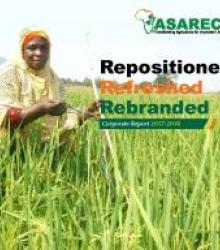| Title | Author | Keywords | Asbract |
|---|---|---|---|
| ASARECA Strategy for Scaling Up Agricultural Technologies and Innovations: 2014 - 2018 | ASARECA | From the time the Association for Strengthening Agricultural Research in Eastern and Central Africa (ASARECA) was founded 20 years ago, its role has been facilitation, coordination, capacity development and mobilisation of financial and other resources for the sub-region agricultural research and development. However, throughout implementation of its first operational plan (2009 - 2013) under its strategic plan 2008 - 2018, ASARECA and its national agricultural research system (NARS) stakeholders have been under mounting pressure to achieve greater impact with its research and development effort. Such impact can only be realised through greater efficiency and effectiveness not only of the generation but also of the delivery and utilisation of the research outputs. The strong commitment of ASARECA to improving the delivery, utilisation and impact of science and technology in order to bring about agricultural transformation in the sub-region is evident in its mission. The Association has responded to these concerns in various ways. Among the responses is a study ASARECA conducted in the sub-region to understand the causes of the low adoption, scaling up and impact of proven technologies and innovations. The study provided insights into the root factors that contribute to low adoption and came up with recommendations for improvement. In its second operational plan (2014 - 2018), ASARECA is focusing more of its interventions in research and development on scaling up. This strategy draws on the insights from the findings of the study on causes of low adoption and borrows experiences and lessons from other regions to provide a holistic way to spur technology uptake and scaling up in ways that will trigger agricultural transformation in sub-Saharan Africa. |
|
| Quality protein maize production and post-harvest handling handbook for East and Central Africa | Godfrey Asea, Julius Serumaga, Zubeda Mduruma, Lydia Kimenye and Moses Odeke | Maize will continue to play a very important role in the livelihoods of most of the population in East and Central Africa (ECA) to meet households needs for food, feed and income. The development and release of quality protein maize (QPM) varieties, which contain high levels of protein has meant that it can be a substitute for the more costly sources of protein for human food such as meat and for fishmeal or artificial lysine used in the production of feeds for poultry and pig enterprises. The handbook was developed by NARS institutions in Kenya, Tanzania, DR. Congo, Uganda in partnership with the Knowledge Management and Upscaling Programme of ASARECA while promoting scaling out of the QPM technologies in these countries under a project known as Dissemination of New Agricultural Technologies in Africa (DONATA). This handbook is a comprehensive one-stop source of information on how QPM is grown using recommended practices to achieve genetic potential of the varieties. It also contains management options for economically important diseases and insect pests, post-harvest handling and utilization. The practices documented in this manual are based on practical experience of researchers in the region who worked with farmers to identify common problems in production of QPM and to validate the improved practices presented in it. These can be applied to other types of maize and areas within the region that broadly fall within the same mega-maize environment. |
|
| Gender Mainstreaming for Food Security: Good Practices, Outcomes and Recommendations from SIMLESA Project | Adeline R. Muheebwa and Yeshi Chiche Gender Mainstreaming Unit ASARECA, CIMMYT | Summary: Gender issues in agricultural research occasion dynamic sets of opportunities and constraints that influence research effectiveness. The project Sustainable Intensification of Maize-Legume cropping systems for food security in Eastern and Southern Africa (SIMLESA) was implemented in Ethiopia, Kenya, Malawi, Mozambique and Tanzania to increase farm-level food security and productivity, in the context of climate risk and change. ASARECA led the gender mainstreaming activities in SIMLESA by conducting capacity building and supporting instrumentation, data management and dissemination. |
|
| Harnessing the potential of diverse intensification pathways for Food and NutritionSecurity and Sustainable Agriculture | ASARECA | Sustainable intensification is generally acknowledged as a major driver for increasing food and nutrition security in Africa. It implies higher agricultural production per unit of resources, labour and/or land. It is not only geared towards increased production of food and biomass, but also towards providing employment and improving livelihoods. Sustainable intensification must play a central role in the management of natural resources such as water, biodiversity, soil nutrients and in the regulation of the carbon cycle. Realizing that much is needed and much is possible, the IntensAfrica Consortium emerged in 2012 with the objectives to document the variety of pathways leading to sustainable intensification, and to align efforts in doing so. African and European members of the consortium agreed to jointly engage in the preparation of a new, strategic, long-term and ambitious re-search and innovation partnership between Europe and Africa in the thematic area of sustainable intensification of agri-food systems. A project named PROIntens Africa was formulated to develop such partnership, and, with funding of the EC, was carried out for two years with active involvement of 23 African and European partners. This report is the final output of this project. |
Search
Project Documents
Copyright © 2025. All rights reserved.
Designed By ASARECA


